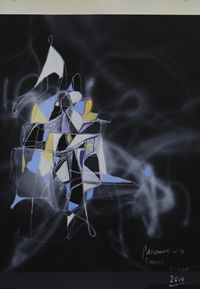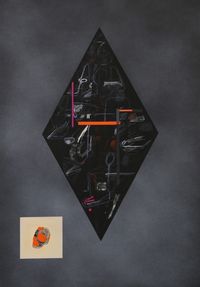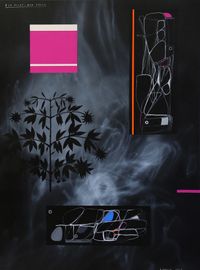Shane Cotton is one of New Zealand’s leading and most celebrated contemporary artists. He was born in Upper Hutt, New Zealand in 1964, and has a BFA from the University of Canterbury in Christchurch, New Zealand. He was a lecturer in the Maori Visual Arts Programme at Massey University until 2005.
Read MoreOf dual Maori (Ngati Rangi, Ngati Hine, Te Uri Taniwha) and Pakeha (European) descent, his iconography borrows widely from both Pakeha and Maori historical sources. Cotton employs a complex set of symbols across his works to speak to contemporary issues of colonisation, cross-cultural exchange, identity and spirituality.
Shane Cotton is key to a generation of young Maori artists who came to prominence in the 1990s for their innovative use of non-traditional materials and processes, while directly addressing concerns of importance to Maori. This generation, including his contemporaries, Michael Parekowhai and Peter Robinson and others, brought a new vision to contemporary art in Aotearoa, New Zealand, and in particular Maori visual art.
Cotton’s characteristic flattened picture plane allows for complex topographies, which also refer to layered and shifting understandings of landscape. In doing so he refers to land ownership and differing understandings of the natural world: from European concepts of the land as something to be divided and sold as property, or for the purpose of economic production, to the earth possessing a spirit in Maori cosmology.
Cotton first established a visual vocabulary in the 1990s that he has gone on to rework inventively for several decades. Recurring motifs include ships, stars, flags, potted plants, birds, chairs, tea pots, cups and architectural structures, evidence of the artist’s interest in the fertile tensions at play in interactions between the native and the introduced, the colonised and the coloniser.
Cotton’s work has been included in many international projects such as Turbulence, The 3rd Auckland Triennial (2007), Paradise Now? Contemporary Art from the Pacific, Asia Society Museum, New York (2004), and he was New Zealand’s representative at the Prague Biennial in 2005. His work was surveyed in a major retrospective exhibition at City Gallery Wellington and Auckland Art Gallery in 2003.
He has also received numerous awards, notably the Frances Hodgkins Fellowship (1998), made a Laureate of the Arts Foundation of New Zealand (2008), and received an ONZM for services to the Visual arts in the 2012 Queen's Birthday Honours. Cotton lives and works in Palmerston North, New Zealand.






